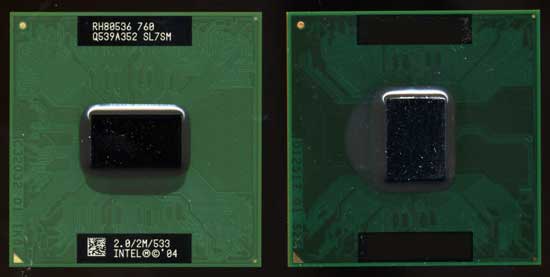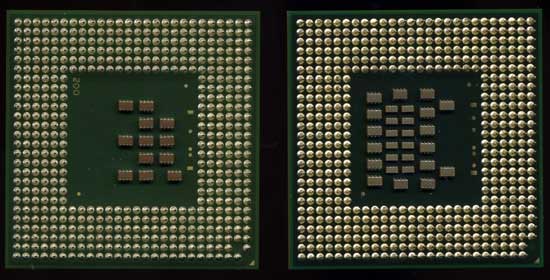Intel Core Duo (Yonah) Performance Preview - Part II
by Anand Lal Shimpi on December 19, 2005 12:55 PM EST- Posted in
- CPUs
It's called the Core Duo
When Yonah first started appearing on roadmaps, we knew it as Jonah, which then starting being written as Yonah. Eventually, Intel confirmed its existence and we had always assumed that it would continue to use the name Pentium M. However, given the great importance of the launch of Intel's first dual-core, low power, notebook processor, it shouldn't be much of a surprise that Intel has a new name in store for it. As you've probably already heard, Yonah will receive the marketing name "Core" with the words "Duo" or "Solo" following it depending on whether it is the dual or single core version. The name Centrino will still be there, but instead of referring to the processor as a Pentium M, it'll be called a Core Duo or a Core Solo. The Centrino platform itself will be referred to as Centrino Duo when paired with a Core Duo processor. We have to admit, we kind of like the new name.
Not so pleasant, however, are the new processor numbers that go along with the new processor names. Gone are Intel's simple three-digit numbers and they have since been replaced with a four-digit number preceded by a letter. The letter indicates the thermal envelope of the processor, while the following four digits denote the performance level of the CPU. If you think that this sounds oddly similar to AMD's Turion processor nomenclature, don't worry; you'd be completely right (of course, the Turion only uses two numbers, while Core Duo uses four). Maybe, one of these days, Intel will get around to copying some more important elements of AMD's history, such as an on-die memory controller or at least a serial bus interface.
As an example of the numbers in use, the 2.0GHz processor that we previewed in the first article will be sold under the name "Intel Core Duo T2500". For your reference, the T2600 will run at 2.16GHz (compared to the 2.0GHz T2500). The Core Solo processors will feature a "1" after the "T" denoting a single core; for example, the Intel Core Solo T1300 will run at 1.66GHz.
Intel's Core Duo and Solo processors both support a 667MHz FSB, which is enabled by the 945 chipset that Intel is pairing with them. The move to a 667MHz FSB is necessary, thanks to the increased bandwidth demands of a dual core processor.
As we mentioned in the first article, the Core Duo (and Solo) processors are not pin-compatible with the older Pentium M, even though they physically have the same number of pins.
When Yonah first started appearing on roadmaps, we knew it as Jonah, which then starting being written as Yonah. Eventually, Intel confirmed its existence and we had always assumed that it would continue to use the name Pentium M. However, given the great importance of the launch of Intel's first dual-core, low power, notebook processor, it shouldn't be much of a surprise that Intel has a new name in store for it. As you've probably already heard, Yonah will receive the marketing name "Core" with the words "Duo" or "Solo" following it depending on whether it is the dual or single core version. The name Centrino will still be there, but instead of referring to the processor as a Pentium M, it'll be called a Core Duo or a Core Solo. The Centrino platform itself will be referred to as Centrino Duo when paired with a Core Duo processor. We have to admit, we kind of like the new name.
Not so pleasant, however, are the new processor numbers that go along with the new processor names. Gone are Intel's simple three-digit numbers and they have since been replaced with a four-digit number preceded by a letter. The letter indicates the thermal envelope of the processor, while the following four digits denote the performance level of the CPU. If you think that this sounds oddly similar to AMD's Turion processor nomenclature, don't worry; you'd be completely right (of course, the Turion only uses two numbers, while Core Duo uses four). Maybe, one of these days, Intel will get around to copying some more important elements of AMD's history, such as an on-die memory controller or at least a serial bus interface.
As an example of the numbers in use, the 2.0GHz processor that we previewed in the first article will be sold under the name "Intel Core Duo T2500". For your reference, the T2600 will run at 2.16GHz (compared to the 2.0GHz T2500). The Core Solo processors will feature a "1" after the "T" denoting a single core; for example, the Intel Core Solo T1300 will run at 1.66GHz.
Intel's Core Duo and Solo processors both support a 667MHz FSB, which is enabled by the 945 chipset that Intel is pairing with them. The move to a 667MHz FSB is necessary, thanks to the increased bandwidth demands of a dual core processor.
As we mentioned in the first article, the Core Duo (and Solo) processors are not pin-compatible with the older Pentium M, even though they physically have the same number of pins.

Dothan (Pentium M) on the left, Yonah (Core Duo) on the Right

Dothan (Pentium M) on the left, Yonah (Core Duo) on the Right










103 Comments
View All Comments
Furen - Monday, December 19, 2005 - link
The P6 has two FP units: An FADD unit and an FMUL unit. One of the big weaknesses of the P6 is the fact that the FMUL unit is not fully-pipelined but instead uses part of the FADD unit for FMUL operations. The K7, on the other hand, has three fully-pipelined units, an FADD, an FMUL and an FSTORE.tayhimself - Monday, December 19, 2005 - link
No he's not. AT's hardware reviewers are nublets. One thing to note though, Dothan FPU is better than the P4's hence its gaming performance advantage over the P4 in the old tests that everyone saw. It's likely that Yonah FPU is still the same as Dothan (similar to P3) and inferior to AMD's.saratoga - Monday, December 19, 2005 - link
Actually the FPU on the P4 was tremendously more powerful then Dothan or Yonah. While games do use the FPU, they're not that bottlenecked by it on modern systems. The reason Dothan did so well was because of its large, very low latency L2 cache. This is roughly equivilent to the primary advantage of the K8, a very low latency memory controller.tayhimself - Monday, December 19, 2005 - link
Youre right about the low latency L1/L2 caches on the Dothan, but the P4 (Williamette/Northwood) has those as well. But the P4 FPU is only powerful in SSE2 mode where it can load store larger chunks of data. Not all games use that unfortunately.saratoga - Monday, December 19, 2005 - link
You're wrong on several points.First:
Dothan L2 latency (clks): 10 clks
Northwood L2 latency (clks): 18 clks (approximately)
So Dothan's L2 cache is roughly 2x as fast and 4x as large. If you compare prescott with its amazingly slow L2, the situation is even more biased towards Dothan. Clearly, in terms of cache performance Dothan has a massive advantage, at least once you're out of the L1.
Second, you're confusing SSE2 and vector processing. While SSE2 can perform vector ops, it also handles plan scaler as well. In x86-64 SSE actually replaces the traditional x87 unit. The relative performance of the two is irrelevent however, the P4 was faster in both.
coldpower27 - Monday, December 19, 2005 - link
Dothan I agree with as having 10 Cycle Cache.
Northwood has 16 Cycle Cache.
Well you also got to keep in mind northwoods clock frequency plays a role in speeding up the cache, accces latencies for Dothan @ 2.0GHZ vs Northwood @ 3.2GHZ are basically equivalent. Though the 2.26GHZ Dothan has the fastest cache of all.
AlexWade - Monday, December 19, 2005 - link
Although, "Core Duo" is a stupid name. Why does Intel have to be so different? "Core Duo" is a little confusing. Is Duo a code name? What?However, despite the stupid name, we've really turned a corner in performance. Intel can make a good CPU when they realized speed isn't the future. Looks like I should start considering replacing my old Pentium-M IBM T40p with the awesome battery life.
AMD needs to respond in kind with a great new CPU. The future looks bright. Competition is once again is good for everyone.
LuxFestinus - Tuesday, December 20, 2005 - link
The ambiguously gay duo, with Ace and Gary.:) An old SNL skit.ksherman - Monday, December 19, 2005 - link
Personally, i dont like that AMD is just sitting back, seemingly waiting for Intel to catch up... They need to kick Intel while their down. these new Processors from intel look really nice and i am likely to buy one, but in a mactel laptop. I am happy for INtel that they are catching up, but AMD really NEEDS to step up and do soemthing new.Calin - Tuesday, December 20, 2005 - link
AMD's income is lower than Intel uses for R&D. You really can't expect from AMD to develop something faster than Intel can.For AMD, to have an processor they could improve a step at a time since the introduction of the Athlon64/Opteron was a need - Intel is able to mantain several teams for microprocessor development, but AMD only has money for one. And AMD will milk the market for as much as possible, selling processors that are easy to make for prices that market will accept. If AMD will start selling a higher processor grade, they would need to reduce the price for lower speed processors. This is why the 2800+ and 3000+ are discontinued - they would have to sell them too cheap.